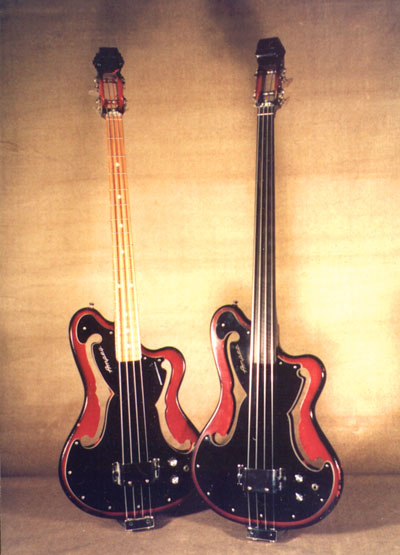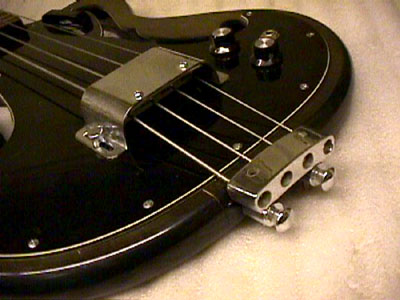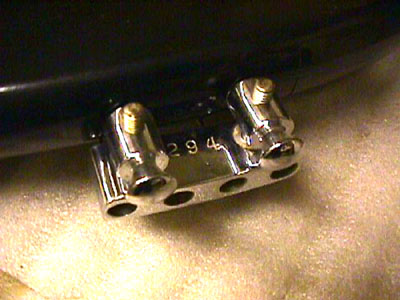
In My Collection:
On the left is AEB-1 #793. It's all original and is very unusual because it's the only
Ampeg I've ever seen with a blonde fingerboard. It's not maple; it appears to be padauk
or bleached rosewood. Unfortunately, this instrument sat in the back room of a music
store without strings for about 12 years, and the neck is twisted. To try to fix it
would probably ruin the rare fingerboard, so I've left it alone.
On the right is AUB-1 #1109, which is a customers' instrument that was here in my shop
for some minor work. It's all original, and is in nice shape. I wish I owned it!
Sorry, these instruments are not for sale!!


The distinctive tailpiece of the AEB-1/AUB-1, which hangs off the back end
of the body on two steel posts. The instrument's serial number is stamped on the underside.
Vintage Ampeg Models:
Vintage Ampeg Main Page
ASB-1 & AUSB-1 Devil Basses
AMB-1 & AMUB-1
SSB & SSUB Short Scale Basses
General Information On Vintage Ampegs:
Setup, Maintenance & Technical Issues
Restorations & Parts
|
|
The AEB-1 (fretted) and the AUB-1 (fretless) were the first horizontal electric basses of
Ampeg's own design, and they are the most commonly recognized of the Scroll Basses.
They feature a scroll headstock, similar to Ampeg's Baby Bass, and a rounded body with two large
F-holes that go all the way through the body. Most of the front surface of the body is
covered by a large black pickguard that wraps around the F-holes. You may think they're beautiful
or you may think they're ugly, but you can't mistake them for any other bass!
The initial development of these instruments was done in the spring of 1966, and they were
introduced to the public at the NAMM show in July 1966. Production started right after the
show and ran into the middle of 1968. A total of about 1150 instruments were built, all by
a small crew of luthiers in Ampeg's Linden, NJ factory.
In addition to the unusual overall appearance, the AEB-1 and AUB-1 have many interesting
technical features that were innovative at the time. The "mystery" pickup, as it was called
in Ampeg's brochures, is buried in the body underneath the bridge. The bridge itself is
mounted on a thin steel diaphragm plate overtop of two big magnetic coils cast into a
large epoxy block. It's not a piezo pickup.
The reason for this unusual pickup is so that the bass could use gut strings! Everett Hull,
Ampeg's founder, was trying to create an electric bass for upright jazz players, and he
thought that fretted basses with metal strings were just a passing fad. Obviously, he was
wrong, and very few of Ampeg's horizontal basses were sold with gut strings on them. Most
were shipped with LaBella flatwounds, and the rest had LaBella black tapewounds. Everett refused
to equip his line of basses with roundwounds, although many players put them on themselves.
The tailpiece on these instruments hangs about an inch off the back end of the body on two
steel posts, and the extra length between the bridge and tailpiece requires special strings
that are about 3" longer than standard Fender length. This was done partly to get the necessary
string angle over the mystery pickup, and also the extra string length allows the strings to
stretch more, so they can be plucked harder like an upright bass.
The necks on all Ampegs are maple, and the center scrolls in the headstocks are actually
molded plastic parts which are glued in place. Most Ampegs have ebony fingerboards, although
some have rosewood. One AEB-1 in my collection has a blonde fingerboard which appears to
be padauk. A few early AEB-1's came from the factory with some custom work; I know of one
with a fully bound fingerboard, and one with elaborate decorative inlays.
The body of the AEB-1 and AUB-1 models is made of three blocks of maple glued onto a
one-piece back cut from 1/4" birch plywood. Over the years, many of these instruments
have developed cracks in the body down near the tailpiece. The pickguards on all Ampegs
are made from a 5-layer engraver's stock, a hard laminate plastic which is used to make
signs and nameplates on trophies.
Because of the difficulty in getting strings and the temperamental nature of the "mystery"
pickup, many AEB-1's and AUB-1's around today have been heavily modified. I've seen dozens
of them where the "mystery" pickup has been trashed and the cavity filled with a block of
wood; then a BadAss or a Fender bridge and a P-bass pickup are installed. These modified
instruments sound okay, but they've lost the characteristic deep Ampeg thump. To me, they're
just a P-bass with a cool headstock. Unfortunately, when the original tailpiece is discarded,
the instrument's serial number is lost.
Mint condition AEB-1's and AUB-1's are rare today. The lacquer finish
typically disintegrated after 15 years, so most are either very badly cracked or chipped,
or have been repainted. Almost all of these models were shipped in a red/black sunburst
color scheme, with clear (amber, now) finish on the back of the neck. A few instruments
in '66 were shipped in other colors, such as solid black, tobacco sunburst, turquoise/black
sunburst, and white with some gold trim. Many of these instruments were actually repainted over
the standard red/black sunburst finish at the factory.
From my research, I estimate that about 750 AEB-1's and 400 AUB-1's were built. The serial
numbers, which are stamped on the underside of the tailpiece, start at #001 and go up to about
#1250. About a hundred of those numbers are ASB-1/AUSB-1 "Devil Basses", which use the same
tailpiece. The highest AEB-1/AUB-1 serial number I've seen so far is #1217.
It's hard to say when AEB-1/AUB-1 production ended. During the summer of '67, while the newer
model AMB-1/AMUB-1 was being developed, some hybrid instruments were built that were a mixture
of the two designs. But some standard AEB-1's and AUB-1's appear to have been built into early
'68, and some unsold instruments were still in Ampeg's inventory in 1970.
|
|

